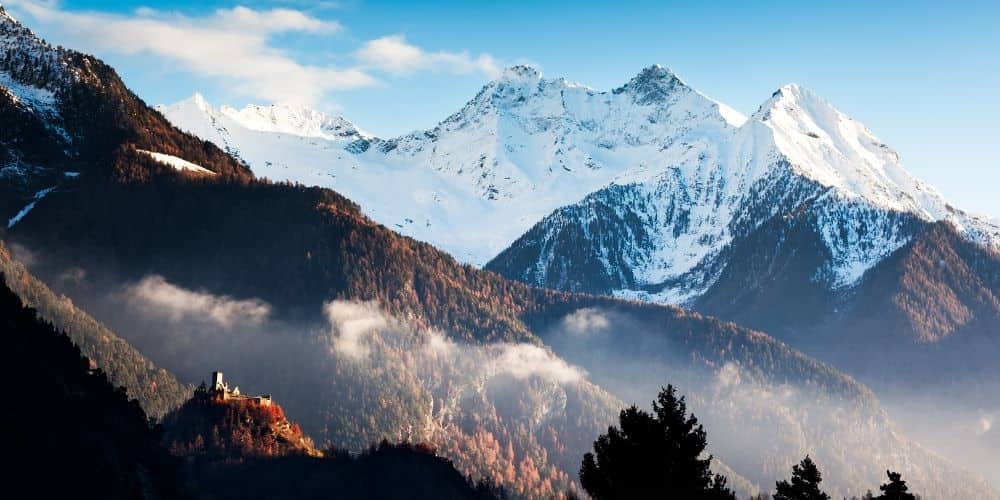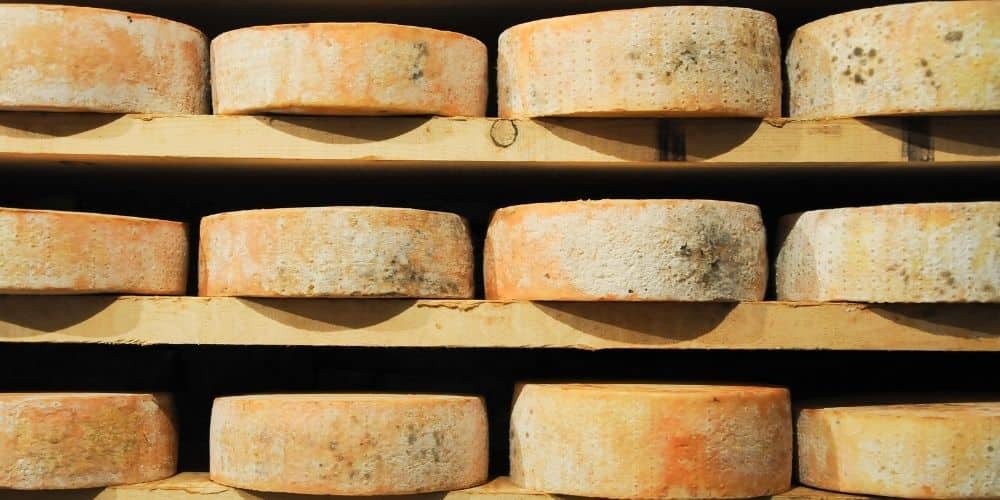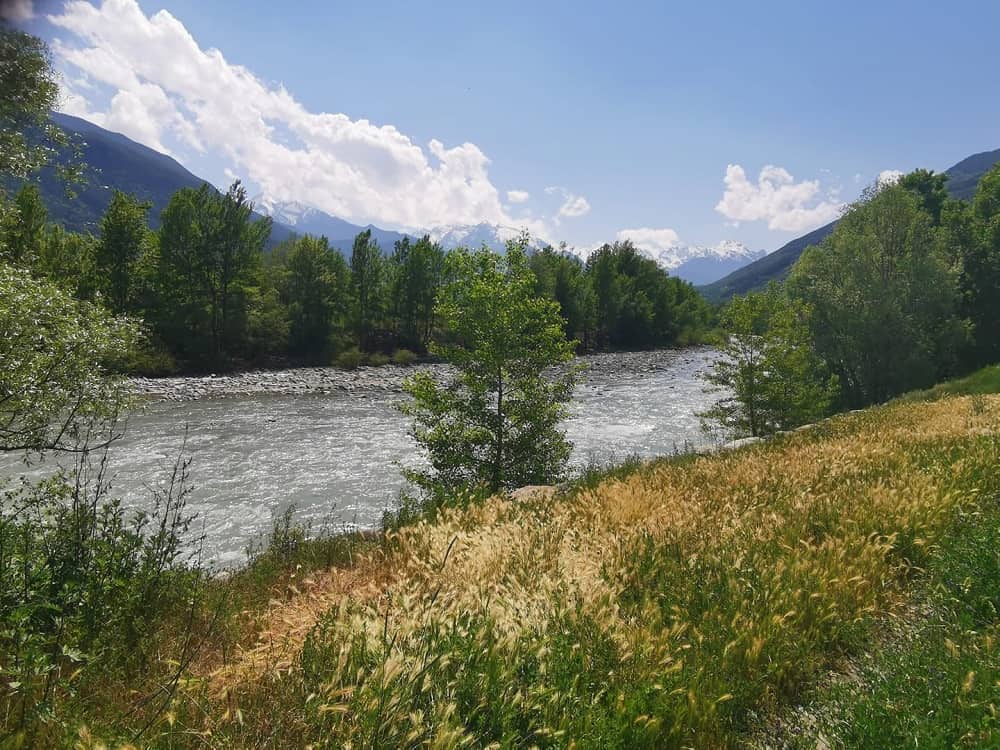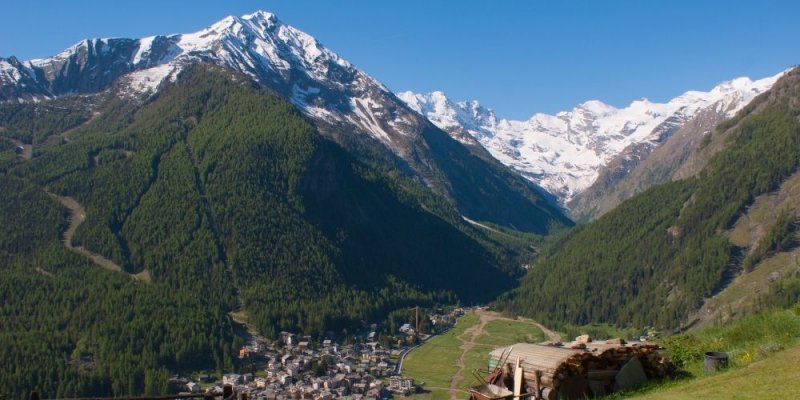Valle d'Aosta: a natural oasis of peace and tranquillity
A mountain holiday has always been a symbol of tranquillity, peace, freedom and health, but with the advent of the Covid-19, an experience far from the chaos of the city is also synonymous with safety.
This is, in fact, what Valle D'Aosta, Italy's smallest region located in the Northwest of the country, is able to offer. There are several features that make Valle d'Aosta an authentic oasis for the visitor who wishes to merge with a serene and distant context of uncontaminated nature.
It is the Italian region with the fewest municipalities, the fewest inhabitants and, consequently, the lowest population density (38 inhabitants per square kilometre compared with the 418, 415 and 332 respectively of Lombardy, Campania and Latium, just to have some terms of comparison for reference). Valle d'Aosta, with its 3,260.85 square kilometres of surface area, is the only Italian region not to be divided administratively into provinces. In fact, the borders of the only province - named Aosta- exactly match with the region's borders.
The region has a minimum altitude of 300 metres and a maximum altitude of 4810 metres, which is higher than anywhere else in Italy. The highest altitude, by the way, is the record held by Monte Bianco 4810 metres), the highest peak of Europe, on the border between Italy and France located between the Italian municipality of Courmayeur and the French municipality of Chamonix.
In addition, Valle d'Aosta is surrounded by 4 mounts that - Monte Bianco included- set it like a jewel. These are the three Giants of the Alps, namely, in order of size, Monte Rosa (4637 m), Cervino (4478 m) and Gran Paradiso (4061 m).

Valle d'Aosta: History and Origins

The Megalithic area of Saint-Martin-de-Corléans, discovered in Aosta in 1969, attests to the presence of human settlements since the Neolithic period. The Cromlech del Piccolo San Bernardo, located on the border between Italy and France, is one of the other places that narrate the first human presence, as well as the succession of peoples and civilizations over the centuries. However, throughout the region, there are numerous traces of prehistoric sites from later periods such as the Copper, Bronze, and Iron Ages. The site at Lignan, at an altitude of 1600 meters in the commune of Nus, is a village dating from the Late Bronze Age and early Iron Age (around 1200-900 BC).
Valle d'Aosta was initially formed by the meeting of the Gallic tribe who penetrated here between the 8th and 5th centuries BC and who, merging and integrating with the indigenous population, gave life to the Salassi tribe. The Salassians later came into contact with the Romans between the 2nd and 1st centuries BC because of their expansionist aims to conquer Gallia and Helvetia (today's France and Switzerland). The defeat of the Salassi, who were forced to surrender to the Romans in 25 BC, led directly to the founding of the colony of Augusta Praetoria, today's city of Aosta, as well as the construction of roads leading to the Piccolo and Gran San Bernardo hills. Subsequently, the region underwent a process of Christianisation from the 4th century onwards and in the 5th century, Aosta became an episcopal seat.
During the early Middle Ages, Valle d'Aosta was fought over, first by the Goths and the Burgundians, and then by the Lombards and the Franks. From 575 onwards, it became part of the Frankish Kingdom and remained so until the fall of the Carolingian Empire in 888. Later, it was incorporated into the Kingdom of Burgundy along with the neighboring transalpine regions that are now French and Swiss territories. With the fall of the Burgundian dynasty in 1032, Valle d'Aosta came under the rule of the founder of the Counts - later Dukes - of Savoy, Count Umberto, and then under the Kingdom of Sardinia. Count Umberto's descendants gained more and more power in the region over the following centuries, subjugating the local lords and making numerous concessions to rural and urban communities. This was the period when castles, towers, and strongholds proliferated throughout the region and were built by aristocratic families such as the Counts of Challant.
The Savoy family maintained control until the 17th century, while from the 16th century until the 19th century the region saw a progressive economic and social decline due to the plague of 1630, which devastated two-thirds of the population, as well as the French occupation and the Napoleonic campaign at the end of the 18th century.
In 1796, Valle d'Aosta was invaded by revolutionary troops and annexed to the French Republic. It belonged to the French Empire for a decade, from 1804 to 1814. Subsequently, the Congress of Vienna and the Restoration of the Savoy monarchy sanctioned the return to the sphere of influence of the reconstituted Kingdom of Sardinia, which became the Kingdom of Italy in 1861, and the annexation of a large part of the peninsula with Nice and Savoy incorporated under French rule.
During the Italian Unification and the First World War, the population of Valle d'Aosta paid a heavy toll in terms of human lives. The creation of the Italian State led to the emergence of political, social, and cultural issues for Valle d'Aosta due to its political and linguistic particularism, which became more acute especially during the Fascist era. As is well known, the phenomenon of forced Italianisation by the Fascist authorities forced the population to adapt and to renounce bilingualism as the only alternative to emigration. With the fall of Fascism and the end of the Second World War, Valle d'Aosta was granted both political and administrative autonomy in 1948 by the Italian State and is now one of the five Italian regions with a special statute.
Valle d'Aosta is a Covid free region due to its natural conformation

Although coastal or art cities are still the most popular destinations, we would like to focus on the importance of fully discovering the benefits of a mountain holiday. First of all, if you are looking for relaxation, the Alpine environment, with its slopes, massifs, forests, valleys and paths is ideal. At a certain altitude, the air is not only pure, as it is free of smog or atmospheric pollution, but also, for example, from 1500 metres upwards, it is a panacea for asthma sufferers or, in particular, for those allergic to dust mites which, as they need humidity to live, find a hostile environment at these altitudes. Furthermore, the presence of negative ions boosts the metabolism and stimulates the immune system. Moreover, all the sports that can be practised in the mountains, both in summer and winter, help to maintain and/or regain physical fitness. Hiking, trekking, cycling, mountaineering, climbing, rafting, canoeing, kayaking, golf, horse riding, fishing, paragliding and canyoning are all activities that improve circulation and the cardiovascular system in general, improve breathing and enhance muscle tone. But of course, walking or practising even one of these outdoor disciplines has an impact on our mood and, thanks to the production of endorphins, induces relaxation and total psychophysical well-being: mens sana in corpore sano (Latin prashe meaning generally translated as "a healthy mind in a healthy body"). In addition to air, another element of fundamental importance in human life is water. This essential and precious substance, which reaches the highest purity at high altitudes, is not only characterised by an incomparable taste but also by the ability to purify the organism at least 3 times more than the water in most of the cities in which we live. The slow rhythm of mother nature's clock is the most powerful stress reliever there is to get away from the hustle and bustle and completely unplug and recharge your batteries. And what about genuine food? Fontina cheese is the authentic protagonist of Valle d'Aosta's gastronomic tradition. One of the most famous typical dishes is the Fonduta, which is a typical speciality where the fontina, the DOP cheese from Valle d'Aosta, is melted in a special pot called chaquelon and eaten hot. Then, the Polenta Concia, a traditional yellow flour polenta with slices of fontina cheese and melted butter, or the delicious Seupa à la Vapelenentse or Zuppa alla Valpellinese, a soup made with stale white bread, fontina cheese, butter, Savoy cabbage and broth, an ancient recipe handed down from grandmothers. And the wine tradition is no less important, considering that the region boasts a very ancient wine vocation that dates back as far as the 1st century AD. White or red wines, PDO and PGI, there is something for everyone, including the delicious Blanc de Morgex et de La Salle, Torrette, Nus Rouge, Chambave Rouge, Arnad-Montjovet, Nus Malvoisie, Enfer d'Arvier and Chambave Muscat.
In a context similar to the one we are currently experiencing, namely the post-pandemic, Valle d'Aosta ensures that your stay, whether short or long, is safe and absolutely covid free. Breathe in the fresh mountain air in complete freedom and without the constraints of a mask, as these areas are known to be the least densely populated. The mountain, by definition, is the least frequented place by mass tourism, which is typical of seaside resorts, and therefore, in a certain sense, have always promoted distancing in their endless forests and isolated alpine paths, without any type of gathering.
There are countless possibilities to choose from, both in terms of activities and, above all, in terms of natural wonders and places of interest to visit and include in your itinerary. This region will provide you with a human-scaled, risk-free stay in spectacular beauty, rediscovering your wellbeing and regaining your lost relationship with nature and the tranquillity of a safe environment.
Safe recommended itineraries and routes

In addition to a regenerating holiday in its own right, Valle d'Aosta offers a rich and varied range of possibilities for visitors of all kinds. With unspoiled landscapes and panoramas set against the backdrop of the Valle d'Aosta Alps, you really will have many options to choose from or to combine with each other to complete your stay in the way you prefer.
For those who love mountain, we recommend the Gran Paradiso National Park, located on the border between Valle d'Aosta and Piedmont. It covers 70,000 hectares of mostly mountainous territory, at an altitude that varies between 800 metres at the bottom of the valley and 4,061 metres of the Mount Gran Paradiso.
It was created by King Vittorio Emanuele III, who decided to cede his territories in the Gran Paradiso area, to the State on the condition that they were turned into a national park for the protection of alpine flora and fauna. As stated in article 1 of the founding decree establishing the park, its purpose is to "conserve the fauna and flora and preserve the special geological formations and the beauty of the landscape".
Created on 3rd December 1922, it is Italy's oldest national park and is the protected area in the Alps with the highest number of fauna species: ibex (the park's symbol), chamois, marmots, ermines, weasels, eagles, green woodpeckers, robins, salamanders and vipers. A total of 167 vertebrate species of which 51 are mammals, 3 amphibians, 8 reptiles, 4 fish and mostly birds (101 species). The flora ranges from forests of larch, spruce, stone pine and rare silver firs on the valley floor to endless alpine pastures at higher altitudes and, as you climb above 4,000 metres, the landscape is covered in rocks and glaciers. The area was declared an Important Plant Area (IPA) because of its richness in plant species - there are no fewer than 968 of them - its biodiversity and the exceptional nature of its rare species. The National Park area includes the valleys of Cogne, Valsavarenche, Rhêmes and Valgrisenche, the slopes that rise from the valley floor towards Mont Fallère and the Vertosan valley.
Vertical, in fact, is a valley located in the municipality of Avise used as a wild pasture where some of the best fontina cheese in Valle d'Aosta are produced. It practically represents the agricultural heart, characterised by the numerous and peculiar alpine pastures, typical of the tradition of Valle d'Aosta and Trentino. The alpine pasture is nothing more than a system of transhumance which consists of moving the cattle to a higher altitude from spring to late summer. The peculiar rustic constructions called malghe (or shepherd's huts) are undoubtedly worth admiring. The farmers produce cheeses of higher quality because the animals also enjoy the benefits of the mountain environment. A verdant and unspoilt locality and little known from a tourist point of view, it is certainly the ideal place for a safe holiday away from the crowds. On either side of it, the valley is populated by beautiful spruce and larch forests that are home to roe deer, deer and chamois and flown over by the majestic golden eagle. The Vertosan valley can be reached from the municipality of Saint-Nicolas, a small village that is definitely worth a visit. Vertosan can also be reached on foot or by mountain bike from the characteristic semi-abandoned village of Vedun. The area is perfect for hiking and, by climbing to the Court de Bard promontory overlooking the central valley at an altitude of 2260 metres, you can enjoy a spectacular view of Mont Blanc and the Gran Paradiso valleys.
The Valpelline is a valley that is hardly known by the normal flow of tourists and has maintained its original aspect of an agricultural mountain where unspoilt nature reigns supreme. It is the longest side valley in the region, stretching from Aosta to the border with neighbouring Switzerland. Some of Valpelline's side valleys, such as Vessona, Verdonaz and Montagnayes, are practically solitary places and even in high season, there are very few people to be found there. They are ideal destinations for wilderness lovers or for those who want to take long walks in total safety.
The Cammino Balteo is also little known and frequented. The name of this particular trail comes from the Dora Baltea, the river that winds its way through the entire region, receiving water from the streams of all the side valleys. Recently established, the hiking trail covers the entire Valle d'Aosta at low altitude, discovering little-known places off the traditional tourist routes. It is a recommended proposal to regenerate body and spirit, particularly after this long period of the pandemic, from spring to autumn. In autumn, the mountains are even less frequented, which is a pity as it is precisely this season that offers clear days with incomparable colours. Lovers of fall foliage and photographs of enchanting landscapes can immortalise this spectacle that nature offers us by taking on the warmest, most vibrant and romantic shades and scents that bring us back to the essence of Mother Earth.
From Mont Saint-Julien to the Becca de Nona, from the Tsatelet Reserve to the Laures Lakes, crossing valleys, hills and forests, we have several outdoor options to consider in order to keep fit and to regain contact with nature by practising trekking and Nordic walking. Not only sport and outdoor activities, but also culture, wellbeing and excellent gastronomic traditions. There are several itineraries to discover this wonderful territory. The churches and castles, for example, are authentic pieces of history and architectural testimonies worthy of interest such as Castel Savoia, Sarre Castle, Fénis Castle, Issogne Castle, Verrès, Ussel, Saint-Pierre, Sarriod de la Tour. There are about sixty castles, fortresses and defensive towers, symbols of a feudal past. Let's not forget the mystical charm of the Cathedral, S. Orso and its collegiate church and S. Lorenzo in Aosta. There are also evocative itineraries of the spirit that bear witness to the great popular devotion of the mountain people: Marian sanctuaries, chapels and votive crosses erected on mountain peaks, on the edges of Alpine lakes or ancient glaciers. Finally, we can walk through part of the ancient Via Francigena, the pilgrimage route from Rome to Canterbury.
Spectacular examples of traditional and modern architecture can also be appreciated in the homes of the famous Walser family bankers in Gressoney, in the villages of Saint-Rhémy and Étroubles and in the villas in Courmayeur. It is also possible to retrace and admire the Roman vestiges left over the centuries by this marvellous civilisation throughout the region, such as the Arch of Augustus, Porta Pretoria and the Roman Theatre in Aosta. A typical example is the Roman bridge-aqueduct or Pont d'Ael, an aqueduct along the road from Aymavilles to Cogne and exactly at the small village of Pont d'Ael. It is an imposing work in masonry and stone blocks, about 56 metres high and over 50 metres long.
Finally, in Valle d'Aosta, there are two of the unique Valdostan villages to be included among the Most Beautiful Villages in Italy: the Valdostan villages of Étroubles and Bard. About 20 km from Aosta, in the heart of the Great St Bernard Valley, the delightful village of Étroubles is particularly charming thanks to its historic centre and the surrounding mountain landscape, where you can breathe in the fine, healthy mountain air. The narrow streets wind their way through houses with beautiful flowered balconies, fountains and traditional shops. Of particular interest is the parish church built in 1815 on the promontory de la Tour where the tower of Étroubles once stood. The stones from this tower were used to build the church. Along the road from Étroubles to the hamlet of Vachéry, we can appreciate the first dairy in of Valle d'Aosta, dating back to 1853. In Vachéry, you can also admire the ancient tower called Tour de la Vachère dating back to the 12th century.
Bard, with about one hundred inhabitants, is the smallest municipality in Italy. With its strategic location along the Roman Consular Road built between 31 and 25 BC, it has always been the centre of commercial and military life. The medieval village, with its almost intact layout, is famous for its approximately 25 historic houses, including Casa Nicole, Casa Challand and Casa Valperga, which have been declared a national monument. From the rocky promontory on which it is situated, the Fortress of Bard stands out, accessible by panoramic lifts and offering numerous possibilities for visits: the Museum of the Alps, the Prisons, the Museum of Fortifications and Frontiers. The fort has become a renowned museum centre, housing temporary and permanent exhibitions at an international level, as well as events and shows throughout the year.
These are just some of the suggestions for discovering or rediscovering the history and age-old traditions of an Alpine region, that is small but rich in treasures. Treat yourself to moments of peace, wellbeing and tranquillity and, above all, a safe holiday.
About the author
Written on 31/05/2021



Alessandra Festa
A holiday dedicated to well-being, tranquillity, and total safety in Valle d'Aosta, the smallest region in Italy, capable of offering whatever the visitor hopes to find.